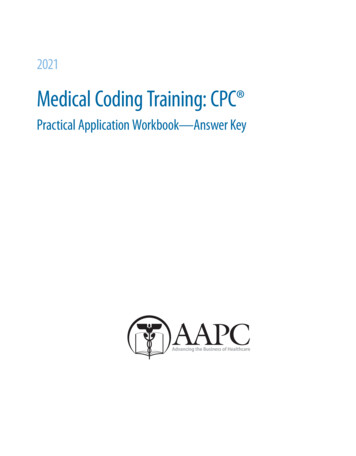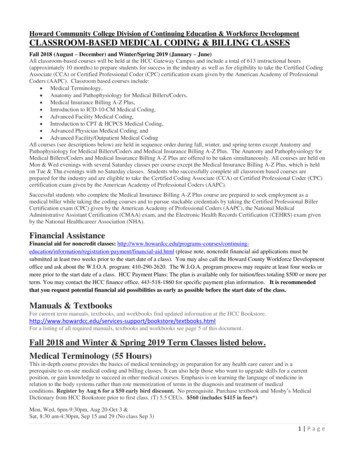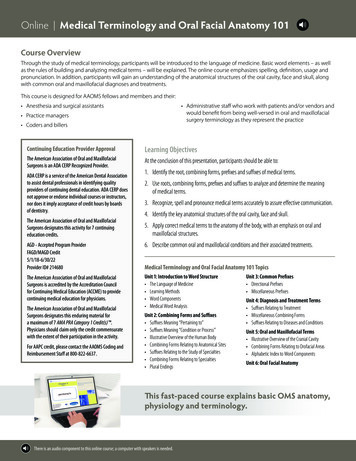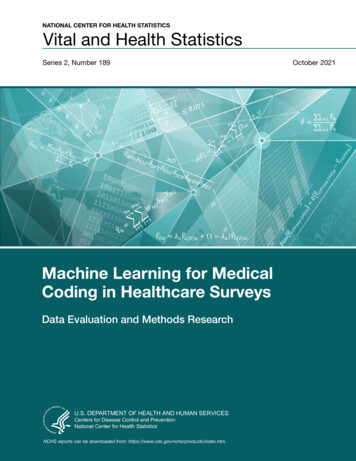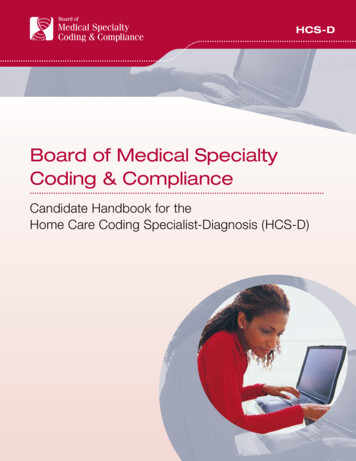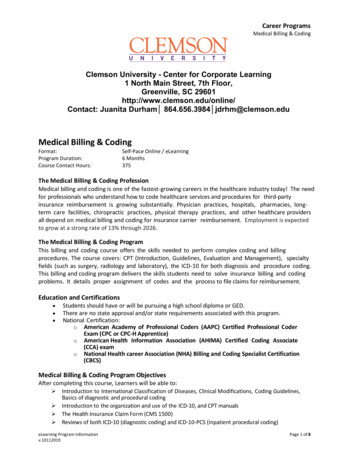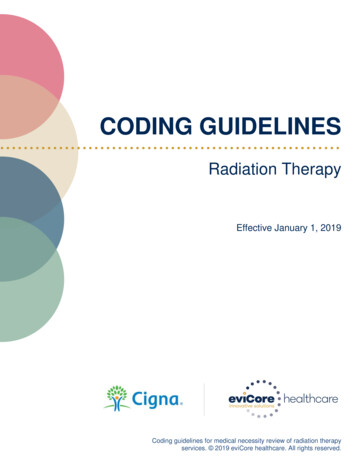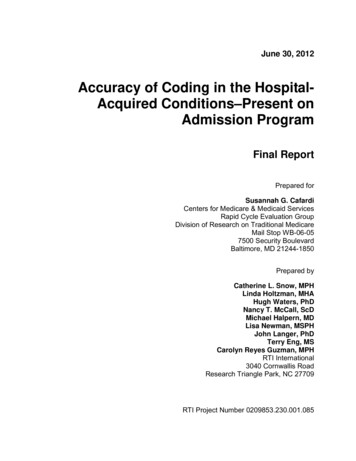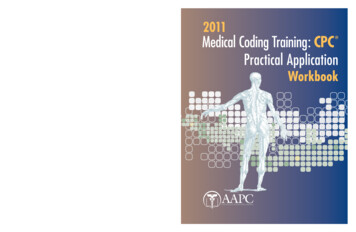
Transcription
ISBN 978-1-935809-36-42011Medical Coding Training: CPCPractical Application WorkbookMedical Coding Training: CPC Practical Application—Workbook2480 South 3850 West, Suite BSalt Lake City, Utah 84120800-626-CODE (2633), Fax 801-236-2258www.aapc.com
Chapter3Introduction to ICD-9-CMExercise 1Directions: Using the ICD-9-CM coding manual, locate the diagnosis codes for thefollowing conditions.1. Fever2. Migraine headache3. Otitis Media4. Epigastric pain5. Acute asthma exacerbation6. Acute myocardial infarction7. Hypertensive heart disease8. Syncope9. Nausea and vomitingCPT copyright 2010 American Medical Association. All rights reserved.www.aapc.com3.1
Chapter3Introduction to ICD-9-CMExercise 1Directions: Using the ICD-9-CM coding manual, locate the diagnosis codes for thefollowing conditions.1. FeverAnswer: 780.60Rationale: From the Index to Diseases, look up Fever. There is no additional information provided. The default code is 780.60. Review the code in the Tabular Index toverify code accuracy.2. Migraine headacheAnswer: 346.90Rationale: From the Index to Diseases, look up Headache/migraine. You are referredto 346.9x. Refer to the code in the Tabular Index. There is no mention of intractablemigraine or status migrainosus; therefore, the fifth digit is “0”. The correct code is346.90.3. Otitis MediaAnswer: 382.9Rationale: From the Index to Diseases, look up Otitis and the subterm media. Thereis no additional information provided. You are referred to 382.9. Review the codein the Tabular Index to verify code accuracy. This is an infection of the middle ear(media).4. Epigastric painAnswer: 789.06Rationale: From the Index to Diseases, look up Pain and the subterm epigastric. Youare referred to 789.06. Review the code in the Tabular Index to verify code accuracy.CPT copyright 2010 American Medical Association. All rights reserved.www.aapc.com3.1
Introduction to ICD-9-CMChapter 35. Acute asthma exacerbationAnswer: 493.92Rationale: From the Index to Diseases, look up Asthma. There is not a subterm foracute or exacerbation. The default code is 493.9x. The fifth digit is “2” to report theacute exacerbation. The correct code is 493.92. Review the code in the Tabular Indexto verify code accuracy.6. Acute myocardial infarctionAnswer: 410.90Rationale: From the Index to Diseases, look up the main term Infarct, infarctionand the subterm myocardium, myocardial. You are referred to 410.9x. Refer to theTabular Index. The fifth digit is determined based on the episode of care which is “0”in this example because the episode of care is not provided.7. Hypertensive heart diseaseAnswer: 402.90Rationale: This code can be located three ways. The first way is check the Index andlook up Disease/heart/hypertensive. The second way is to look in the HypertensionTable under Hypertension/with/heart involvement /Unspecified. Also listed in theHypertensive Table is Hypertension/heart/Unspecified. This example is coded asunspecified because no additional information is provided. Review the code in theTabular Index to verify code accuracy.8. SyncopeAnswer: 780.2Rationale: Look up Syncope in the Index to Diseases. You are referred to 780.2.Review the code in the Tabular Index to verify code accuracy.9. Nausea and vomitingAnswer: 787.01Rationale: From the Index to Diseases, look up Nausea/with vomiting. You arereferred to 787.01. Review the code in the Tabular Index to verify code accuracy.3.22011 Medical Coding Training: CPC Practical Application Workbook—InstructorCPT copyright 2010 American Medical Association. All rights reserved.
Musculoskeletal SystemChapter 8Case 10Preoperative diagnosis: Right ankle triplane fracturePostoperative diagnosis: Right ankle triplane fractureProcedure: Open reduction and internal fixation (ORIF) right ankle triplane fractureAnesthesia: General endotrachealComplications: NoneSpecimen: NoneImplant used: Synthes 4.0 mm cannulated screwsIndications for procedure:The patient is a pleasant 15-year-old male who fell and sustained a right ankle triplanefracture. This was confirmed on both X-ray and CT scan. Explained to the patient areindications for ORIF as well as possible risks and complications which include but arenot limited to infection, bleeding, stiffness, hardware pain, need for hardware removal,no guarantee of functional ambulatory result. The patient and the family understood andwished to proceed.Procedure in detail:The patient was brought back to operating room and placed on an operating table, givena general anesthetic without any complications, given preoperative antibiotics per usualroutine. He had right lower extremity prepped and draped in the usual sterile fashionwith alcohol prep followed by routine Betadine prep.Under X-ray guidance, a pointed reduction clamp was placed from the anterolateralcorner of the distal tibia to the medial side and reduced the triplane fracture. It wasconfirmed on both AP and lateral X-ray images that the gap was reduced. The patientthen had guidewires taken from the Synthes 4.0 mm cannulated screw set, placed onefrom medial along the epiphysis on the anterior half of the epiphysis and parallel to thejoint to catch the lateral aspect of the epiphysis. Then one screw was placed above thephysis from anterior to posterior to capture that spike. Once wires were in appropriateposition, length was measured, partially threaded 4.0 mm cancellous screws were selectedso that all threads were across the fracture site. Appropriate length screws were placed,confirmed by X-ray to be in good position. Fracture was anatomically reduced, and anklejoint was anatomic. The patient had wounds copiously irrigated out. Closure was donewith interrupted horizontal mattress 3-0 nylon suture. The patient had sterile compressive dressing, was placed into a 3-sided posterior mold splint, was extubated and broughtto recovery room in stable condition. There were no complications. There were no specimens. Sponge and needle counts were equal at the end of the case.What are the CPT and ICD-9-CM codes reported?8.102011 Medical Coding Training: CPC Practical Application WorkbookCPT copyright 2010 American Medical Association. All rights reserved.
Musculoskeletal SystemChapter 8Case 10Preoperative diagnosis: Right ankle triplane fracture1. Postoperative diagnosis isused for coding.2. Stated procedure.3. General endotrachealanesthesia used.1.Postoperative diagnosis: Right ankle triplane fracture2.Procedure: Open reduction and internal fixation (ORIF) right ankle triplane fracture3.Anesthesia: General endotrachealComplications: None4. Radiologic guidance used.Specimen: None5. Confirms fracture andtreatment were of the distaltibia.Implant used: Synthes 4.0 mm cannulated screwsIndications for procedure:The patient is a pleasant 15-year-old male who fell and sustained a right ankle triplanefracture. This was confirmed on both X-ray and CT scan. Explained to the patient areindications for ORIF as well as possible risks and complications which include but arenot limited to infection, bleeding, stiffness, hardware pain, need for hardware removal,no guarantee of functional ambulatory result. The patient and the family understood andwished to proceed.6. Fracture reduced.7. Internal fixationaccomplished with screws.Procedure in detail:The patient was brought back to operating room and placed on an operating table, givena general anesthetic without any complications, given preoperative antibiotics per usualroutine. He had right lower extremity prepped and draped in the usual sterile fashionwith alcohol prep followed by routine Betadine prep.4.5.7.Under X-ray guidance, a pointed reduction clamp was placed from the anterolateral6.corner of the distal tibia to the medial side and reduced the triplane fracture. It wasconfirmed on both AP and lateral X-ray images that the gap was reduced. The patientthen had guidewires taken from the Synthes 4.0 mm cannulated screw set, placed onefrom medial along the epiphysis on the anterior half of the epiphysis and parallel to thejoint to catch the lateral aspect of the epiphysis. Then one screw was placed above thephysis from anterior to posterior to capture that spike. Once wires were in appropriateposition, length was measured, partially threaded 4.0 mm cancellous screws were selectedso that all threads were across the fracture site. Appropriate length screws were placed,confirmed by X-ray to be in good position. Fracture was anatomically reduced, and anklejoint was anatomic. The patient had wounds copiously irrigated out. Closure was donewith interrupted horizontal mattress 3-0 nylon suture. The patient had sterile compressive dressing, was placed into a 3-sided posterior mold splint, was extubated and broughtto recovery room in stable condition. There were no complications. There were no specimens. Sponge and needle counts were equal at the end of the case.What are the CPT and ICD-9-CM codes reported?CPT codes: 27827-RTICD-9-CM code: 824.88.182011 Medical Coding Training: CPC Practical Application Workbook—InstructorCPT copyright 2010 American Medical Association. All rights reserved.
Chapter 8Musculoskeletal SystemRationale:CPT codes: In the CPT Index, look under Fracture, tibia, distal and you are directedto code range 27824-27828. This code range is for open treatment with internalfixation (ORIF). The treatment was of the distal tibia making 27827 the correct codeselection.ICD-9-CM code: The diagnosis is stated as a right ankle triplane fracture. A triplaneankle fracture refers to a fracture in the distal tibia in three planes. In the alphabetic index, look for fracture, ankle, you are directed to 824.8. Verification of 824.8confirms it codes to fracture of the ankle, unspecified. There is not a “not otherwisespecified” code for a fracture of the ankle, so this would be correct.CPT copyright 2010 American Medical Association. All rights reserved.www.aapc.com8.19
Chapter 19Evaluation and ManagementChest/breast: Breasts normal to inspection with no deformity, no breast tenderness ormasses.GI: Soft, non-tender, without masses, hernias or bruits. Bowel sounds are active in all fourquadrants.GU: external/vaginal: Normal in appearance with good hair distribution. No vulvarirritation or discharge. Normal clitoris and labia. Mucosa clear without lesions. Pelvicsupport normal.Cervix: The cervix is clear, firm and closed. No visible lesions. No abnormal discharge.Specimens taken from the cervix for thin prep.Uterus: Uterus non-tender and of normal size, shape and consistency. Position andmobility are normal.Adnexa/Parametria: No masses or tenderness noted.Lymphatics: No lymphadenopathy in the neck, axillae, or groin.Musculoskeletal exam: Gait intact. No kyphosis, lordosis, or tenderness. Full range ofmotion. Normal rotation. No instability.Extremities: bilateral lower: No misalignment or tenderness. Full range of motion.Normal stability, strength and tone.Skin: Warm, dry, no diaphoresis, no significant lesions, irritation, rashes or ulcers.Neurologic: CNS II-XII grossly intact.Psychiatric: Mood and affect appropriate.Labs/Radiology/Tests: The following labs/radiology/tests results were discussed with thepatient: Alb, Bili, Ca, Cl, Cr, Glu, Alk Phos, K, Na, SGOT, BUN, Lipid profile, CBC, TSH,Pap smear.Assessment/plan:244.9 Unspecified acquired hypothyroidismWhat are the CPT and ICD-9-CM codes reported?CPT copyright 2010 American Medical Association. All rights reserved.www.aapc.com19.5
Evaluation and Management4. Breast exam.Chapter 194.Chest/Breast: Breasts normal to inspection with no deformity, no breast tenderness ormasses.5. Thin prep Pap smearcollection.GI: Soft, non-tender, without masses, hernias or bruits. Bowel sounds are active in all fourquadrants.6. Pelvic exam.GU: external/vaginal: Normal in appearance with good hair distribution. No vulvarirritation or discharge. Normal clitoris and labia. Mucosa clear without lesions. Pelvicsupport normal.5.Cervix: The cervix is clear, firm and closed. No visible lesions. No abnormal discharge.Specimens taken from the cervix for thin prep.6.Uterus: Uterus non-tender and of normal size, shape and consistency. Position andmobility are normal.Adnexa/Parametria: No masses or tenderness noted.Lymphatics: No lymphadenopathy in the neck, axillae, or groin.Musculoskeletal exam: Gait intact. No kyphosis, lordosis, or tenderness. Full range ofmotion. Normal rotation. No instability.Extremities: Bilateral Lower: No misalignment or tenderness. Full range of motion.Normal stability, strength and tone.Skin: Warm, dry, no diaphoresis, no significant lesions, irritation, rashes or ulcers.Neurologic: CNS II-XII grossly intact.Psychiatric: Mood and affect appropriate.Labs/Radiology/Tests: The following labs/radiology/tests results were discussed with thepatient: Alb, Bili, Ca, Cl, Cr, Glu, Alk Phos, K, Na, SGOT, BUN, Lipid profile, CBC, TSH,Pap smear.Assessment/Plan:244.9Unspecified acquired hypothyroidismWhat are the CPT and ICD-9-CM codes reported?CPT Code: 99395—for some insurance carriers, also code G0101 for the pelvic andbreast exam.ICD-9-CM Code: V70.0, V72.31, 244.919.62011 Medical Coding Training: CPC Practical Application Workbook—InstructorCPT copyright 2010 American Medical Association. All rights reserved.
Chapter 19Evaluation and ManagementRationale: CPT Codes: Subcategory—Preventive Medicine Services, establishedpatientAge 33—code 99395Some insurance carriers will also allow reporting of HCPCS Level II code G0101 forthe pelvic and breast exam. The Pap smear results were discussed with the patientduring the visit indicating the Pap analysis was performed in the office. If we had aPap report, we could also bill for the Pap smear.ICD-9-CM Codes: In the ICD-9-CM index, look for examination, annual and you aredirected to V70.0. There is also a code for examination, pelvic, which is V72.31. Theprovider also has documented unspecified acquired hypothyroidism. Since theprovider confirmed her medication compliance, this can be listed as an additionalcode. Note: Some payers will require specific ICD-9-CM codes be reported withscreening pelvic and breast exams. Check your payer policies.CPT copyright 2010 American Medical Association. All rights reserved.www.aapc.com19.7
Medical Coding Training: CPC Practical Application Workbook 2480 South 3850 West, Suite B Salt Lake City, Utah 84120 800-626-CODE (2633), Fax 801-236-2258 www.aapc.com ISBN 978-1-935809-36-4 Medical Coding Training: CPC Practical Application— Workbook 2011

